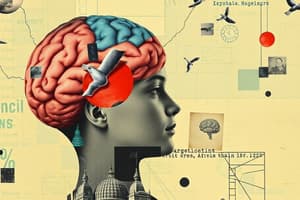Podcast
Questions and Answers
During adolescence, individuals are at increased risk for which of the following affective disorders?
During adolescence, individuals are at increased risk for which of the following affective disorders?
- Depression and anxiety disorders (correct)
- Schizophrenia
- Bipolar disorder
- Obsessive-compulsive disorder
What is one reason why adolescents may engage in greater risk-taking behavior, particularly in social contexts?
What is one reason why adolescents may engage in greater risk-taking behavior, particularly in social contexts?
- To optimize the key goals of adolescence
- To develop their identity
- To seek out rewarding activities
- To gain independence from their caregivers (correct)
Which neural structure has a stronger regulatory impact in adults compared to adolescents?
Which neural structure has a stronger regulatory impact in adults compared to adolescents?
- Striatum
- Hippocampus
- Prefrontal cortex (correct)
- Amygdala
Why is exploration important for adolescents?
Why is exploration important for adolescents?
According to the text, which region of the brain is more developed in adolescents compared to the prefrontal cortex?
According to the text, which region of the brain is more developed in adolescents compared to the prefrontal cortex?
Which model of brain development emphasizes the interaction between the limbic system and the cognitive control system?
Which model of brain development emphasizes the interaction between the limbic system and the cognitive control system?
According to the imbalance model, which system reaches maturity around adolescence and then plateaus?
According to the imbalance model, which system reaches maturity around adolescence and then plateaus?
What is the focus of the triadic model of brain development?
What is the focus of the triadic model of brain development?
Which of the following is true about adolescence?
Which of the following is true about adolescence?
What is meant by reaching an 'adult-like cognitive or behavioral capacity'?
What is meant by reaching an 'adult-like cognitive or behavioral capacity'?
What contributes to the development of adult-like cognitive capacity?
What contributes to the development of adult-like cognitive capacity?
Which part of the brain is the last to fully mature during development?
Which part of the brain is the last to fully mature during development?
Which of the following is NOT a structural change in the brain during puberty?
Which of the following is NOT a structural change in the brain during puberty?
At what age does the second phase of puberty, gonadarche, typically occur in males?
At what age does the second phase of puberty, gonadarche, typically occur in males?
What is the HPG axis?
What is the HPG axis?
What is the paradox referred to as in adolescence, where they understand they're cognitively mature but make poor decisions?
What is the paradox referred to as in adolescence, where they understand they're cognitively mature but make poor decisions?
Which of the following is NOT a factor that influences risk-taking behavior in adolescents?
Which of the following is NOT a factor that influences risk-taking behavior in adolescents?
What is the main purpose of the Chein et al. 2011 study mentioned in the text?
What is the main purpose of the Chein et al. 2011 study mentioned in the text?
At what age does adolescence typically start according to the text?
At what age does adolescence typically start according to the text?
What are some characteristics of adolescence mentioned in the text?
What are some characteristics of adolescence mentioned in the text?
According to the text, which of the following models emphasizes the role of imbalanced development between reward and cognitive control systems in driving risky behaviors?
According to the text, which of the following models emphasizes the role of imbalanced development between reward and cognitive control systems in driving risky behaviors?
What are the two brain systems focused on in the Dual Systems Model?
What are the two brain systems focused on in the Dual Systems Model?
Which brain regions are highlighted in all three models as playing a role in shaping adolescent behavior?
Which brain regions are highlighted in all three models as playing a role in shaping adolescent behavior?
What neural evidence supports the idea that cognitive capacity does not equal cognitive control?
What neural evidence supports the idea that cognitive capacity does not equal cognitive control?
Which of the following is a reason why adolescents are more vulnerable to affective disorders like depression and anxiety?
Which of the following is a reason why adolescents are more vulnerable to affective disorders like depression and anxiety?
What is one of the reasons why the majority of individuals who have an affective disorder in adolescence continue to have it in adulthood?
What is one of the reasons why the majority of individuals who have an affective disorder in adolescence continue to have it in adulthood?
Why is adolescence considered a key window for learning and discovery?
Why is adolescence considered a key window for learning and discovery?
What is one way in which the effects of earlier adversity can be mitigated during adolescence?
What is one way in which the effects of earlier adversity can be mitigated during adolescence?
What is one of the things the author is interested in understanding about the brain changes during adolescence?
What is one of the things the author is interested in understanding about the brain changes during adolescence?
What makes adolescence a vulnerable period for affective disorders?
What makes adolescence a vulnerable period for affective disorders?




